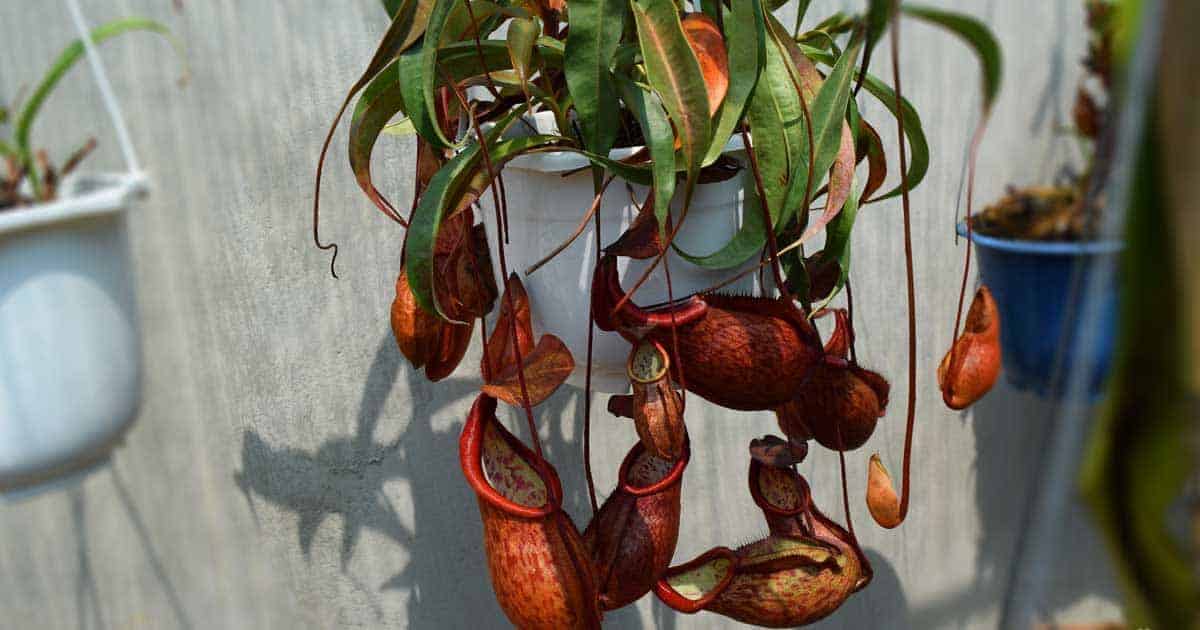The many types of carnivorous plants are a strange variation of plant life which approaches some of the characteristics of animal life, at least those of catching and devouring their prey.
Most of these flesh-eaters have insignificant flowers, which are often not allowed to form.

This permits more intensive development of the primary source of interest, the leaves, with intricate mechanisms for trapping insect life and retaining its catch until it is completely absorbed.
Three (Groups) Types Of Carnivorous Plants
Carnivorous plants can roughly be divided into three groups.
There are those which live above water yet drown their prey
Those which live submerged, trapping water insects
Those which have movable leaf parts to close upon their victims.
The Pitcher Plants (Nepenthes)
Among these, the pitcher plants (Nepenthes), sometimes called cobra plants, give a good account of themselves in the window garden if specific needs are catered to.
Some florists once sold Sarracenia flava to enthusiasts who wanted to grow the unusual.
The pitcher plants produce at the tips of their leaves pitchers that range from mug-shape to graceful pear-shape.

Inside the pitchers hair’s point downward, allowing an insect to enter easily, to enjoy the sweet substance near the opening, beckoning him on step by step.
Because of the direction of the hairs, the victim cannot possibly emerge.
Their fate is eventually to drop into the water in the base of the pitcher where they inevitability drowns and digested.
Pitchers are complete with trapdoor-like covers and some have flexible streamers which help to attract insect life.
The plants digest minute portions of ground beef, a helpful substitution in these days of insect-free homes.
The shaded colorings of the pitchers are wonderful to see, particularly the sizes, shapes, and hues of the hybrids.
Nepenthes atrosangninea has long, narrow, graceful pitchers colored maroon and greenish-yellow.
Nepenthes chelsoni excelsa is flask-shaped.
Nepenthes maxima are deep red with a few mottlings of yellow-green.
Nepenthes balfouriana and chelsoni both have pitchers with fringed wings.
Colors sometimes grow lighter with age, the deep tones of some varieties show green mottlings as they grow older.
The Sarracenia flava
The yellowish leaves of Sarracenia flava may attain a length of 30″ inches.
The yellow-green pitchers are trumpet-shaped with red throats or all-red with heavy veins.
The care of pitcher plants is not too difficult if certain necessities are provided.
These include a potting soil of sphagnum peat moss and horticultural sand to withstand the constant moisture needed for the well-being of the bog plants.
Filtered sunlight, frequent spraying and watering, humid atmosphere and temperatures ranging from 65°-80° degrees Fahrenheit are other requisites, though the plants do stand some variation.
Sarracenia flava may be grown in a pot containing acid peat and sand or sphagnum and sand. This particular plant is a good one to start out with.
After you have got the “hang” of Sarracenia flava try one of the hybrids with the impossibly colored pitchers.
Submerged Insectivorous Plants
In the second group, we find submerged insectivorous plants.
Here we find an old friend to aquarium lovers and pool enthusiasts, the bladderwort (Utricularia vulgaris) which is much used in aquaria and pools.
The small leaves, equipped with bladders, grow under water or partially submerged.
The yellow flowers may stand a full six inches above the water. The tiny leaf-bladders have a trap-door opening only inward.
Water insects enter the open door which closes until the meal is assimilated.
Related: Check out the Fungicide Azoxystrobin that Boosts Growth in Venus Flytraps
Strickly Hairs
The third group does not rely on pitchers or traps but uses the simpler methods of sticky hairs, leaves which roll up or leaves which appear nearly normal but are hinged, with folding parts.
The cape sundew (Drosera) has many very sticky hairs which finally entangle the insect.
The butterwort (Pinguicula) has only sticky hairs which hold the insect till it is digested.
Venus flytrap (Dionaea muscipula) works in an entirely different but nonetheless effective way.
Its leaves consist of two hinged parts lined with stiff hairs.
Having settled on the leaf, insects are restrained by the hairs until the leaf segments fold shut to crush them.
Its leaves may be caused to close by touching them with the point of a pencil.
The closing at a touch, the opening again after the food has been digested, are uncanny characteristics which seem most un-plant like!